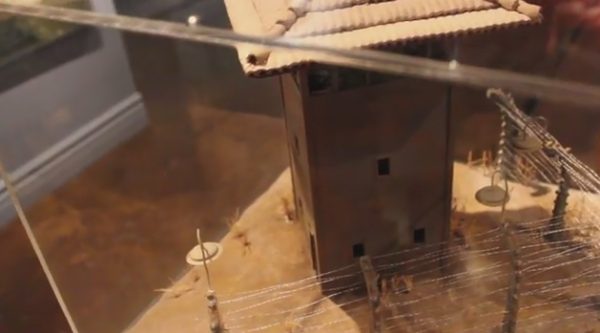Concentration camp survivor David Kaplan says that art speaks louder than words. In 1941, when Kaplan was 12 years old, he and his family were sent to separate concentration camps. Although he survived four years at several camps, his brother perished in Landsberg, his mother and sister were killed in Majdanek.
The 88-year-old believes that it is often better for survivors to write poems and create art to represent the Holocaust rather than to simply recount their personal experience.
Creating art about a dehumanizing experience like the Holocaust can bring hope to people who are the victims of such traumatizing events.
“When you lose hope, you cannot survive,” said Kaplan, a local businessman, who has produced paintings after his internment in concentration camps.
Sylvia Cohen, co-founder El Paso Holocaust Museum And Study Center, says that a hyper realistic photo of the face of a holocaust survivor can have greater emotional impact than a poem. “How many people read poems today?” said Cohen, who works at Jewish Community Center.
She added that poetry and art gave the camp inmates a reason to stay alive. On a tour of a concentration camp, Cohen said she saw small decaying clay figures of animals that had been sculpted by the inmates.
 Sherry Smith, a docent at the museum, agrees that poems and images were a crucial part of the struggle to survive during the holocaust. She also says that some children wrote poems while they were in the camps.
Sherry Smith, a docent at the museum, agrees that poems and images were a crucial part of the struggle to survive during the holocaust. She also says that some children wrote poems while they were in the camps.
Cindy Baca, whose nine-year-old son Orlando is attending a day camp this month at the Holocaust museum, said that she has read “poetry from people who actually experienced the Holocaust and that was actually a way for them to escape” from their imprisonment.
“Having people share their stories and by having children read books about the Holocaust is a wonderful way to teach our kids about the Holocaust,” Baca said.
She also said public schools are not doing enough to teach schools about the Holocaust. “That’s why my son is here. There has to be so much more education on this. I don’t even believe they’re touching the tip of the iceberg.”
Jamie Flores, programing and education director of the El Paso Holocaust Museum, said, “knowing that parents often bring their younger children we have started to address how can we really teach this history to an eight-year-old who might be interested and have a lot of questions but we don’t want them to find out about the ‘final solution’ or we don’t want them to learn about Auschwitz yet. That’s really too much for an eight-year-old,” Flores said. She added that the Holocaust museum addresses this by hosting a summer camp and year round programs for children ages 8 to 12. “They are really able to dig into this history but in a way that’s not going to traumatize them,” she said.
For additional information about the children’s program: http://www.elpasoholocaustmuseum.org/
